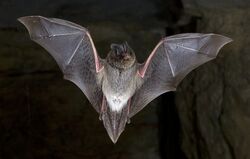Biology:Barbastelle
| Barbastelle | |
|---|---|

| |
| Scientific classification | |
| Script error: No such module "Taxobox ranks".: | <div style="display:inline" class="script error: no such module "taxobox ranks".">Animalia |
| Script error: No such module "Taxobox ranks".: | <div style="display:inline" class="script error: no such module "taxobox ranks".">Chordata |
| Script error: No such module "Taxobox ranks".: | <div style="display:inline" class="script error: no such module "taxobox ranks".">Mammalia |
| Script error: No such module "Taxobox ranks".: | <div style="display:inline" class="script error: no such module "taxobox ranks".">Chiroptera |
| Script error: No such module "Taxobox ranks".: | <div style="display:inline" class="script error: no such module "taxobox ranks".">Vespertilionidae |
| Script error: No such module "Taxobox ranks".: | <div style="display:inline" class="script error: no such module "taxobox ranks".">Barbastella |
| Script error: No such module "Taxobox ranks".: | <div style="display:inline" class="script error: no such module "taxobox ranks".">B. barbastellus |
| Binomial name | |
| Barbastella barbastellus (Schreber, 1774)
| |
The barbastelle (Barbastella barbastellus), also known as the western barbastelle, is a European bat. It has a short nose, small eyes and wide ears.
It is rare throughout its range. In Britain, only a few breeding roosts are known; Paston Great Barn in Norfolk, parts of Exmoor and the Quantock Hills in Devon and Somerset (see Tarr Steps), Wimpole Wood in Cambridgeshire, the Mottisfont woodland in Hampshire and Ebernoe Common in West Sussex. The UK distribution can be found on the National Biodiversity Network website here.[2] In Norway, it was considered extirpated, having only been sighted in 1896, 1911, 1913 and 1949. However, it was again found in 2004 and 2008.[3]
In the Netherlands the last barbastelle was seen hibernating in 1991, in Flanders, Belgium, the species survived a few years longer, but was also considered extirpated until a small population was rediscovered in 2015.
Habitat
They roost in splits or behind loose bark of trees all year, normally in ancient or old growth deciduous woods that have a substantial understorey. Damaged or dead trees are the ideal habitat. They move between the roosts with great frequency.
Protection
They are protected under the European Habitats Directive. In the UK their rarity means that woodlands containing the species may be considered for notification as a Site of Special Scientific Interest and may attract a grant under Natural Englands Environmental Stewardship scheme.
Echolocation
The barbastelle has two main call types used for echolocation. The frequency parameters of call type 1 lie between 30–38 kHz, have most energy at 33 kHz and have an average duration of 2.5 ms.[4] The frequency parameters of call type 2 lie between 29–47 kHz, have most energy at 38 kHz and have an average duration of 4.1 ms.[4][5]
Evolutionary arms race
The barbastelle has, like the rest of the animal kingdom of this world, participated in an evolutionary arms race. The foe for the bat order Chiroptera is its prey, the moth order Lepidoptera. To minimize the risk of the bats' echolocation, moths [and in rarest examples, butterflies] have evolved to detect the echolocation calls of hunting bats, and evoke evasive flight manoeuvres, or reply with their own ultrasonic clicks to confuse the bat's echolocation. The Arctiidae subfamily of Noctuid moths uniquely respond to bat echolocation in three prevailing hypotheses: startle, sonar jamming, and acoustic aposematic defence. All these differences depend on specific environmental settings and the type of echolocation call; however, these hypotheses are not mutually exclusive and can be used by the same moth for defence.[6]
In response, to continue the race, some bat families are known to use clicks at frequencies above or below moths' hearing ranges. This is known as the allotonic frequency hypothesis. It argues that the auditory systems in moths have driven their bat predators to use higher or lower frequency echolocation to circumvent the moth hearing. Barbastelle bats have evolved to use a quieter mode of echolocation, calling at a reduced volume and further reducing the volume of their clicks as they close in on prey moths. The lower volume of clicks reduces the effective successful hunting range, but results in a significantly higher number of moths caught than other, louder bat species. Moths have further evolved the ability to discriminate between high and low echolocation click rates, which indicates whether the bat has just detected their presence or is actively pursuing them. This allows them to decide whether or not defensive ultrasonic clicks are worth the time and energy expenditure.
References
- ↑ Piraccini, R. (2016). "Barbastella barbastellus". The IUCN Red List of Threatened Species (IUCN) 2016: e.T2553A22029285. doi:10.2305/IUCN.UK.2016-2.RLTS.T2553A22029285.en. http://www.iucnredlist.org/details/2553/0. Retrieved 9 November 2017.
- ↑ Barbastella barbastellus, Joint Nature Conservation Committee, retrieved on September 1, 2008.
- ↑ NTB (22 April 2008). "Hemmelighetskremmeri om "utdødd" flaggermus" (in Norwegian). Archived from the original on 2008-09-17. https://web.archive.org/web/20080917020921/http://www.aftenposten.no/viten/article2384356.ece. Retrieved 2008-04-22.
- ↑ 4.0 4.1 Parsons, S.; Jones, G. (September 2000). "Acoustic identification of twelve species of echolocating bat by discriminant function analysis and artificial neural networks". The Journal of Experimental Biology 203 (Pt 17): 2641–2656. PMID 10934005. http://jeb.biologists.org/content/203/17/2641.full.pdf.

- ↑ Obrist, Martin K.; Boesch, Ruedi; Flückiger, Peter F. (2004). "Variability in echolocation call design of 26 Swiss bat species: Consequences, limits and options for automated field identification with a synergetic pattern recognition approach". Mammalia 68 (4): 307–322. doi:10.1515/mamm.2004.030. http://www.slf.ch/wsl/info/mitarbeitende/obrist/pdf/5194.pdf.
- ↑ Yager, David D. (2012-04-01). "Predator detection and evasion by flying insects". Current Opinion in Neurobiology 22 (2): 201–207. doi:10.1016/j.conb.2011.12.011. ISSN 1873-6882. PMID 22226428.
External links
- ARKive page about barbastelles
- Woodland Management For Bats Guide
- www.worlddeer.org/britishbats/barbastelle
- IUCN
Wikidata ☰ Q215907 entry

